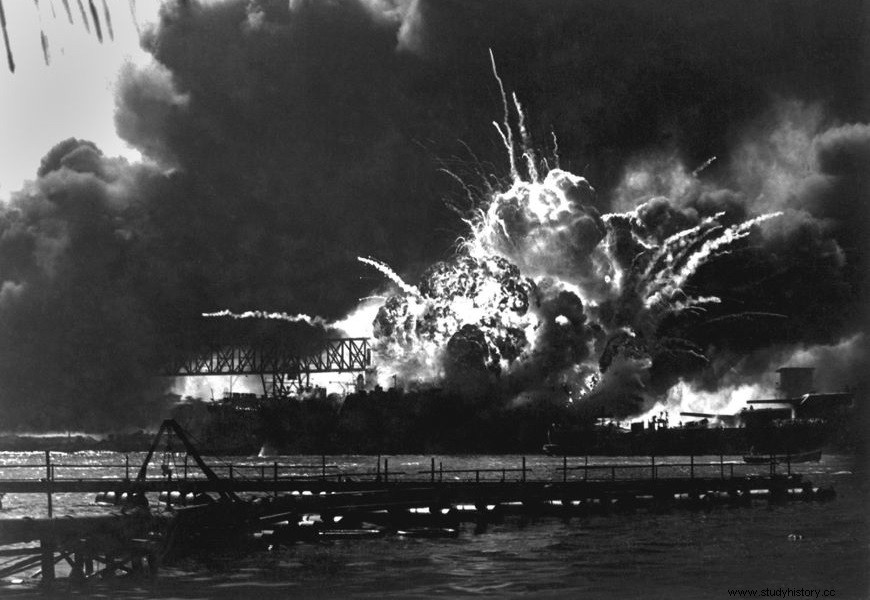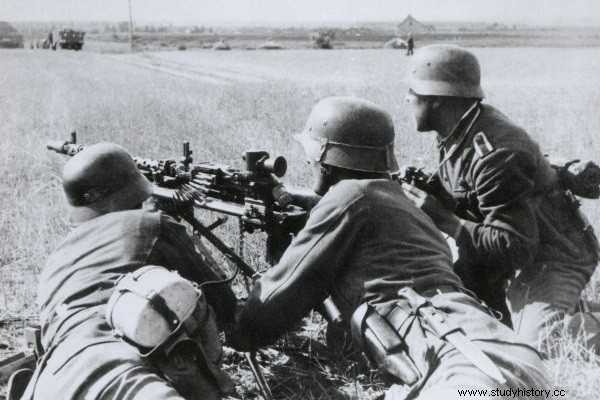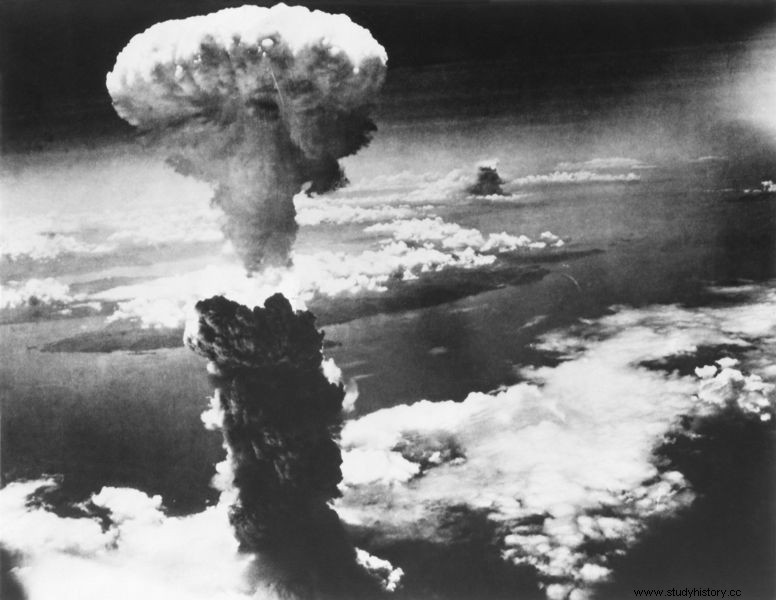The World War II it was the greatest conflict of humanity, taking place from 1939 to 1945, in different parts of Oceania, Asia, Africa and Europe. This conflict was fought between Allies (UK, France, USA, USSR etc.) and Axis (Italy, Germany, Japan etc.) and resulted in the death of approximately 60 million people and significant material destruction.
The Second World War was directly caused by the German expansionism during the 1930s. The trigger for the conflict came with the invasion of Poland carried out by the Germans, in September 1939. The Second World War was marked by the horrors of the Holocaust and the dropping of the atomic bombs.
See more :Einsatzgruppen - Nazi death squads that operated during World War II
Causes
The Second World War is related to the expansion of totalitarianism in Europe and was directly caused by expansionism Germanic in that period. Furthermore, the defeat in the First War became a source of humiliation and the cause of a serious economic crisis that hit Germany in the 1920s.
This scenario allowed the rise of far-right radicalism , whose maximum exponent was Nazism. The Nazis criticized the terms of the Treaty of Versailles, advocated the militarization of Germany, and held openly anti-Semitic views. The growth of the Nazis during the Weimar Republic (1919-1933) was exponential, largely because of Adolf Hitler.
The Nazis finally took power in Germany in 1933 and began building a totalitarian government. Progressively, they sought to recover the German economy and reorganize the German army (which had been disorganized since the First World War). Once the German military forces were strong enough, territorial expansion began.
The territorial expansion defended by the Germans was part of an element of the Nazi ideology that advocated the formation of a “space vital ” that would house the Aryans. The prosperity of the Germans would be guaranteed through the exploitation of people seen as “inferior”, such as the Slavs.
In the late 1930s, Germans initially turned against Austria, a nation historically with a German language and culture. Plans for unification of Germany and Austria had been aired after World War I, but were barred during the negotiations that led to the signing of the Treaty of Versailles.
Login also :Learn about the Brazilian participation in World War II
In 1938, the Germans began a massive campaign to ensure the unification of the two countries. This came to fruition in March 1938, in an event known as the Anschluss . Then the Germans turned against Czechoslovakia, because of a region of that country called Sudetes .
German demands on the Sudetenland alarmed the British and French, and diplomatic tension in Europe increased. To circumvent this situation, the Munich Conference was organized , in 1938. At that conference, the British and French, fearful that a war was going to start, gave in to German pressure and allowed the Germans to invade Czechoslovakia.
An important point of the Munich Conference is that the British and French demanded from Hitler a compromise that Czechoslovakia would be Germany's last territorial demand . Hitler made this deal, but he was bluffing. He didn't believe the British and French would have the courage to declare war on the Germans.
So, in 1939, Hitler set his sights on Poland. As the tension between Germany and Poland increased, the British and French signed military agreements with the second country to protect it in case of aggression by the first. As Hitler did not believe the French and English response, he ordered the attack on Poland on September 1, 1939.
This act of aggression was considered the fuse of World War II, as, days later, the United Kingdom and France declared war on Germany.
Participating countries
World War II had dozens of participating nations, with varying degrees of involvement in the war effort. This conflict was fought by Axis nations against Allied nations, being:
- Allies :UK, France, USA and USSR (main forces);
- Axis :Germany, Italy and Japan (main forces).
Stages of War

World War II lasted six years and reached a level of mobilization called by historians total war. These years can be divided into three phases, which are:
- 1st phase (1939-1941) :was marked by the supremacy of German and Japanese forces in the conflict. The Germans, through the blitzkrieg , managed to conquer a number of European nations. The Japanese, in turn, began their expansion through Southeast Asia, conquering the colonies of the British, French and Dutch. In addition, the Japanese carried out an attack that caused great damage to the Americans, at Pearl Harbor.
- 2nd phase (1942-1943) :this is the moment when the situation of the Second World War began to reverse itself. The Germans were stopped by the Soviets at the famous Battle of Stalingrad, and the Germans' war power began to decline. The same happened to the Japanese, who, after the defeat in the Battle of Midway , they lost a considerable part of their war power and were slowly defeated by the Americans.
- 3rd phase (1944-1945) :Moment when Axis members are defeated. Allied forces in Europe surrounded the Germans and led the invasion of German territory at the turn of 1944 to 1945. The Japanese began to suffer more and more from US bombing. Internally the country was collapsing, but the Japanese refusal to surrender led the Americans to hit Japan with two atomic bombs. The Axis' defeat brought the war to an end.
Also read :Ustasha – the fascist party that ruled Croatia with the support of the Nazis
Highlights
World War II was an extensive conflict, marked by a multitude of events and many twists and turns. As mentioned, the war started with the invasion of Poland in September 1939. Polish territory was conquered by the Germans in a few weeks and was divided between Germans and Soviets due to a clause in the Non-Aggression Treaty. Let's look at the main events.
-
Blitzkrieg
From 1939 to 1940, there was a period of little action known as the Lie War . From 1940, the Germans began their offensives across Europe and conquered Norway, Denmark, Belgium, Holland, France, Yugoslavia, Greece, etc. The great German conquests left the Nazi High Command excited about the country's war capabilities.
These advancements were only possible because of the blitzkrieg , an innovative war tactic for the time and which coordinated multiple attacks by different forces of the German army. Driven by the success of blitzkrieg , Adolf Hitler ordered an attack against the Soviet Union. That event changed the fate of World War II.
-
Invasion of the Soviet Union

The Operation Barbarossa was started by the Germans on June 22, 1941 and mobilized over three million soldiers , plus thousands of planes, tanks and artillery pieces. The attack was initiated based on the tactic of the blitzkrieg and made rapid advances possible for the Germans. The objective was to conquer the Soviet Union within eight weeks .
Gradually, the Soviets' war effort and Germany's lack of resources to fight on two war fronts were decisive in stopping the German advance. At the end of 1941, the Germans had three major targets to conquer in the USSR.
These targets were:
- Leningrad , a city that the Germans planned to conquer leaving the population to starve to death. It was not until 1944 that the German siege against Leningrad was broken;
- Moscow , the Soviet capital. The Germans reached the outskirts of Moscow and were less than 30 km from the Kremlin, but the weakening of their forces pushed them back from the outskirts of the city;
- Stalingrad , city in the south of the USSR. The Germans tried to conquer it as a way of controlling the Caucasus and thus guaranteeing them important resources, such as oil. The division of German forces and stubborn resistance led them to defeat in the biggest battle of World War II. It is estimated that the death toll in Stalingrad was two million people.
The defeat at Stalingrad weakened Germany considerably. The amount of resources available to the country was drastically reduced and its industrial capacity fell. Basically, the Germans didn't have material and financial conditions to support the effort that the war in the USSR demanded, and they had known this since late 1941.
German Defeat
There were significant defeats suffered by the Germans on Soviet territory after Stalingrad. The biggest highlight, in this sense, is Kursk , a fundamental battle for the Germans that ended in their defeat because they were forced to retreat in order to reinforce their lines in Italy. The Germans had been expelled from North Africa, and with that, Italy was invaded from the south.
They lost control overItaly, reconquered by the Allies . The leader of Italian fascism, Mussolini, was killed by guerrillas fighting the Nazis. In Eastern Europe, the Germans were pushed back by millions of Soviet soldiers. Places such as Estonia, Poland, Hungary, among others, were reconquered as Soviet forces advanced.
The D-Day , held on 6 June 1944, opened a new Allied war front against the Nazis and increased pressure on the Germans. In 1945, the Allies entered German territory, and Berlin, the country's capital, was conquered in April. Adolf Hitler committed suicide and in May 1945 Germany surrendered .
Login also :The main events that marked the Second War in Asia
Japan's Defeat

Japan's defeat officially took place in September 1945. The fight against the Americans had begun in December 1941, when the Japanese attacked the US naval base at Pearl Harbor, Hawaii. The supremacy of the Japanese over the Americans in the War of the Pacific was short-lived:in June 1942, Japanese power was severely undermined.
This month took place the Battle of Midway , a major naval air strike that resulted in the destruction of four Japanese navy aircraft carriers . After that, the Japanese were never able to regain their power in the fight against the US. Little by little, those accumulated defeats and were pushed back into their territory.
The Japanese suffered in countless battles, as in Guadalcanal , in Philippines , in Okinawa etc. In 1945, the Americans carried out massive bombing raids on major Japanese cities. Their last step was to invade Japan's main island, but to prevent that, they made use of a cruel weapon.
Two bombs atomic were launched, one over Hiroshima and another about Nagasaki , on the 6th and 9th of August, respectively. The launch was not enough to convince members of the Japanese government to offer surrender. The invasion of Manchuria by Soviet troops, from 9 August, was the shovel of lime on the Japanese government. On September 2, 1945, the Japanese signed the surrender and ended World War II.
Image credits
[1] Everett Historical and Shutterstock
